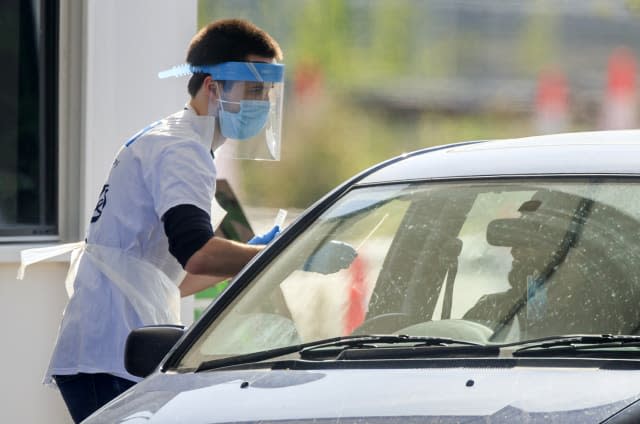Local teams more successful in Test and Trace than call centres and online

Local health protection teams continue to be more successful than call centre workers at reaching close contacts of people who have tested positive for coronavirus, according to the latest data.
Test and Trace figures from the Department of Health and Social Care (DHSC) show that, for cases handled by local teams, 98.0% of close contacts of people who tested positive for Covid-19 have been reached and asked to self-isolate.

By contrast, for those cases handled either online or by call centres, 56.1% of close contacts have been reached and asked to self-isolate.
The figures were published amid concerns about the effectiveness of the operation, with experts warning that the NHS Test and Trace system must rapidly improve to cope with the pressures expected once schools fully return in September and as winter approaches.
There has been a consistent gap between local teams and call centres/online since the Test and Trace system launched.
NHS Test and Trace [23 July – 29 July]
➡️ 4,642 positive cases transferred to service➡️ 72% reached to provide contacts
➡️ 19,150 contacts identified➡️ 72% of close contacts were reached and advised to self-isolate
— Department of Health and Social Care (@DHSCgovuk) August 6, 2020
In the first week, for cases handled by local teams, 99.7% of close contacts of people who tested positive for the virus were reached and asked to self-isolate, while for cases handled either online or by call centres the figure was 52.5%.
This trend has continued week-on-week, with similar percentages recorded.
Reports have suggested that some contact tracers working for the NHS Test and Trace programme in England are making just a handful of calls a month.

Some councils have taken matters into their own hands and launched local contact-tracing operations to supplement the national system.
Calderdale Council, which covers Halifax and surrounding areas, is the second authority to make the move after Blackburn and Darwen said it was setting up a locally focused system to utilise community knowledge.
But senior officials insist that the Test and Trace programme is not at odds with local systems, and is working in partnership with local authorities and their local health protection teams.
The test, trace and isolate system is critical but it’s still not working properly.
Time is running out for the Government to fix it. pic.twitter.com/UBnlgk8fXN
— Keir Starmer (@Keir_Starmer) August 5, 2020
Meanwhile, around three in four people (77.9%) who were tested for Covid-19 in the week ending July 29 at a regional site or mobile testing unit – a so-called “in-person” test – received their result within 24 hours.
This is up on 76.4% in the previous week, but down on 90.8% in the week to July 1.
Prime Minister Boris Johnson had pledged that, by the end of June, the results of all in-person tests would be back within 24 hours.
He told the House of Commons on June 3 he would get “all tests turned around within 24 hours by the end of June, except for difficulties with postal tests or insuperable problems like that”.

Since the launch of Test and Trace, 199,524 close contacts of people who have tested positive for Covid-19 have been reached through the tracing system and asked to self-isolate.
This is 82.2% out of a total of 242,749 people identified as close contacts.
The remaining 43,225 people (17.8%) were identified as close contacts, but were not reached.
The weekly figures show that 72.4% of close contacts were reached in the week ending July 29, down from 76.2% in the previous week, and down on the 90.7% reached in the first week of Test and Trace (week ending June 3).
Labour leader Sir Keir Starmer, during a visit to north Wales, said: “We don’t need a world-beating track and trace system, we need an effective one and we haven’t got it.
Key message from our modelling paper: test trace isolate system is critically important and getting better but coverage must further increase.
— Chris Bonell (@bonell_chris) August 4, 2020
“This is vital to everything that happens. If this doesn’t work it’s very difficult to see how we’re going forward.”
Elsewhere, the authors of a modelling study said that without appropriate levels of testing and contact tracing, reopening of schools together with gradual relaxing of the lockdown measures are “likely to induce a second wave that would peak in December 2020 if schools open full-time in September”.
The study by researchers from UCL and the London School of Hygiene and Tropical Medicine (LSHTM), published in The Lancet Child And Adolescent Health, warned that in a worst-case scenario a second wave could be 2.3 times higher than the first.
But its authors said that “with increased levels of testing… and effective contact tracing and isolation, an epidemic rebound might be prevented”.
One of the authors, Chris Bonell, professor of public health sociology at LSHTM, said the key message from the modelling paper was that the “test, trace isolate system is critically important and getting better, but coverage must further increase”.
Meanwhile in Scotland, bars, cafes and restaurants in Aberdeen were ordered to close over a coronavirus cluster in the area.
A five-mile travel rule has been put in place and residents are being told not to enter each other’s houses.
First Minister Nicola Sturgeon said there were concerns about “a significant outbreak in Aberdeen that may include some community transmission”.


